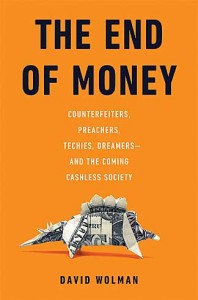
Yep, there was once a time when that penny you spotted on the pavement was worth something more than just one cent. You could buy lots of things for a penny back then, and saving them was rewarding on many levels.
Now they’re tossed and forgotten in desk drawers and fountains, or lost beneath cushions. You almost can’t give pennies away these days, and you probably won’t bother picking one up off the pavement.
But what will happen if critics get their wish and pennies are eliminated? Or paper dollars, or $100 bills? Find out in the new book “The End of Money” by David Wolman.
For most of human history, people lived quite nicely without money.
We traded and bartered, which worked fine until it became necessary to keep track of inequalities in resources and trading. Specified objects were the first markers of wealth and commerce, with the invention of coins not far behind.

And ever since, our attitudes toward money have been mixed.
You’ve heard, for example, that money is the root of all evil but to some, credit cards are the Devil’s vehicle to the End Times. Others hate that “filthy lucre” can be taken literally, and that cash and coins “harbor all kinds of bugs.” And because money doesn’t grow on trees, still others point to the huge resources required to make coins and bills, only some of which is sustainable.
Still, though it costs money to make money, the government keeps on producing it (for a tidy profit) and we keep on using it, knowing that it’ll always be around. The words “In God We Trust” are nice, in fact, but the reason money works is because we trust the government to uphold its value.
Still, much like every transaction, we get change.
If it seems like you rarely see $100 bills, it’s because most of them go overseas for drug deals and crime. If it seems like our paper cash is constantly changing, it’s to stay one half-step ahead of counterfeiters. And if it seems like there’s got to be a better, more efficient way than our paper-and-metal method, there is… and it might be as close as your pocket.
If you look after your pennies, they say, your dollars will take care of themselves. But “The End of Money” looks at both, and what you’ll learn is surprising.
With thoughts worth way more than a penny, author David Wolman tried for several months not to touch cash, partly as an experiment for this book and partly because of money’s germiness. He traveled during this time, to countries with jaw-dropping inflation, places where cash is not king, villages in which poor people learn how to collect wealth, and locales where counterfeiters hope you’ll repeatedly part with foolish money.
Whether you’ve got greenbacks or gravy, pennies, pounds, or plastic in your pocket, I think you’ll find “The End of Money” extremely interesting. Money might not buy happiness, but reading this book is the next best thing.
The Bookworm is Terri Schlichenmeyer. Terri has been reading since she was 3 years old and she never goes anywhere without a book. She lives on a hill in Wisconsin with two dogs and 12,000 books.
